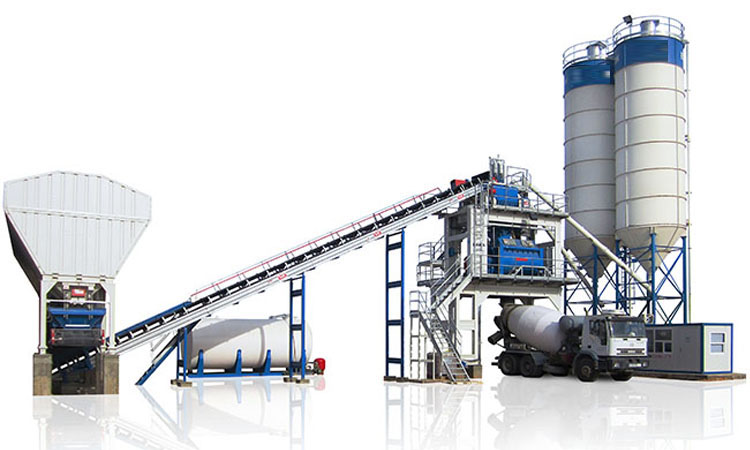Categories
- Case & News (50)
- Blog (566)
A concrete plant, also known as a batch plant or batching plant or a concrete batching plant, is equipment that combines various ingredients to form concrete. Some of these inputs include water, air, admixtures, sand, aggregate (rocks, gravel, etc.), fly ash, silica fume, slag and cement. A concrete plant can have a variety of parts and accessories, including: mixers (either tilt drum or horizontal or in some cases both), cement batchers, aggregate batchers, conveyors, radial stackers, aggregate bins, cement bins, heaters, chillers, cement silos, batch plant controls, and dust collectors. The heart of the concrete batching plant is the mixer, and there are many types of mixers such as Tilt Drum, Pan, Planetary, Single Shaft and Twin Shaft mixer. The twin shaft mixer can ensure an even mixture of concrete through the use of high horsepower motors, while the tile mixer offers a consistent mix with much less maintenance and cost.

There are two main types of concrete batching plants: Dry mix plants and Wet mix plants, and also plants that contain both a transit mix side and a central mix side while utilizing common material storage points. A Dry mix Concrete Plants, also known as Transit Mix Plants, weighs sand, gravel and cement in weigh batchers via digital or manual scales . All the ingredients then are discharged into a chute which discharges into a truck. Meanwhile, water is either being weighed or volumetrically metered and discharged through the same charging chute into the mixer truck. These ingredients are then mixed for a minimum of 70 to 100 revolutions during transportation to the jobsite. A Wet mix Concrete Plants, combines some or all of the above ingredients (including water) at a central location into a Concrete Mixer – that is, the concrete is mixed at a single point, and then simply agitated on the way to the jobsite to prevent setting (using agitators or ready mix trucks) or hauled to the jobsite in an open-bodied dump truck. Dry mix differ from Wet mix plants in that Wet Mix contain a central mixer whereas dry, which can offer a more consistent mixture in a shorter time (generally 5 minutes or less). Dry mix plants typically see more break strength standard deviation and variation from load to load because of inconsistencies in mix times, truck blade and drum conditions, traffic conditions, etc. With a Central Mix plant, all loads see the same mixing action and there is an initial quality control point when discharging from the central mixer. Certain plants combine both Dry and Wet characteristics for increased production or for seasonality. Both Wet Mix batch plant and a Dry Mix plant can be computer assisted using a batch computer.
Different types of concrete batching plants types are available for a variety of applications. Typical plants are used for ready mix, civil infrastructure, and precast applications. Concrete batching plant can be used for all kinds construction, such as for bridge construction, road construction, high speed railway construction, building construction and municipal construction, etc. Since now you have had a basic understanding of the concrete batching plant, you may want to ask where to buy a concrete plant. Here we sincerely recommend you the outstanding concrete plant manufacturer, that is Haomei Machinery in Zhengzhou, Henan Province, China. This company specializing in the research, design and production of construction and mining machinery for more than 30 years. Concrete plants produced by Haomei Machinery have been sold to many countries and had been highly praised by customers all over the world. Their site: https://www.concretebatchplant24.com, hope you find perfect concrete batching plant at Haomei Machinery like others.